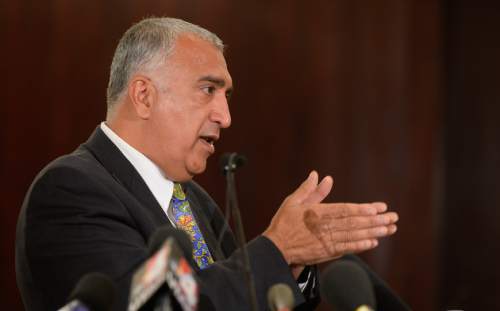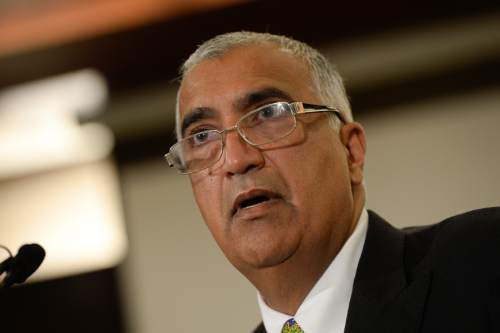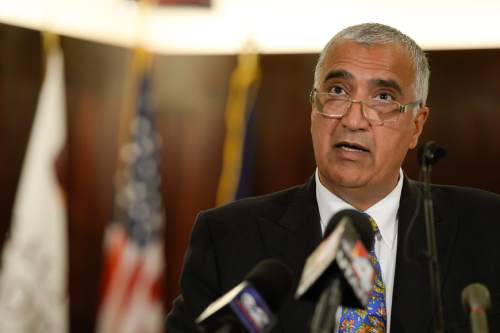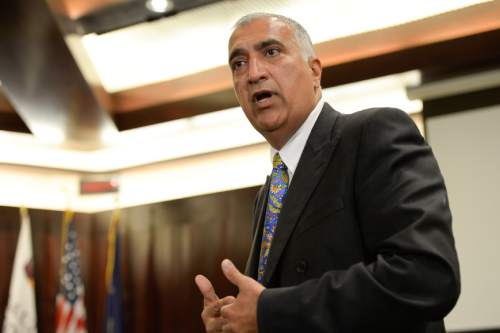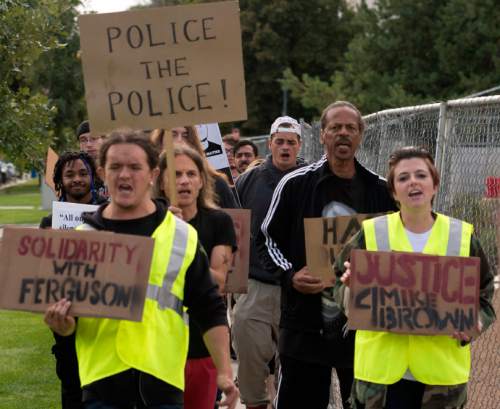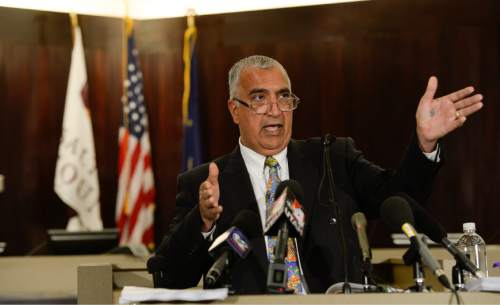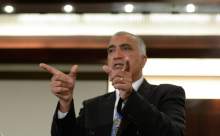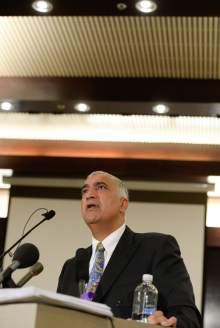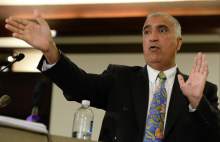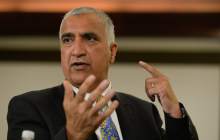This is an archived article that was published on sltrib.com in 2014, and information in the article may be outdated. It is provided only for personal research purposes and may not be reprinted.
Dillon Taylor was not armed when a Salt Lake City police officer shot him to death outside a convenience store.
But in that moment on Aug. 11, Officer Bron Cruz had good reason to think Taylor was pulling a gun out of his pants, Salt Lake County District Attorney Sim Gill ruled on Tuesday.
Taylor, 20, and the two men he was with matched the descriptions of a 911 caller who said three men had "flashed" a gun. And Cruz saw them "making a scene" on their way to the 7-Eleven near 2100 S. State Street.
Confronted by officers, the two men with Taylor held up their hands, while Taylor alone was "noncompliant."
Body-cam video shows that Taylor turned toward officers with his hands in his pants before hoisting his shirt — a gesture officers are trained to recognize as a possible weapon-draw.
"Nothing that Mr. Taylor did assisted in de-escalating the situation," Gill said. "If anything, it escalated things."
Taylor's shooting was justified, Gill said, not because he posed an actual threat, but because Cruz reasonably perceived a threat.
"Officer Cruz's belief that Dillon Taylor was armed with a gun and intended to use it against the officers was reinforced by Dillon's actions and the acts of others," Gill wrote in a letter to Salt Lake City Police Chief Chris Burbank. "By the time Dillon drew his hands from his waistband, Officer Cruz's belief that Dillon was presenting a weapon [and ... would use the weapon against officers] was reasonable."
Taylor's shooting, which occurred just one week after the controversial shooting of Michael Brown in Ferguson, Mo., led to multiple protests this summer by Taylor's family, friends and activists who say forceful tactics by police in Utah and nationwide deserve greater scrutiny.
"I don't see how this could possibly be ruled justified!" wrote administrators of the Facebook group Justice For Dillon Taylor, which has more than 3,300 members.
Gill was 30 minutes late to a Tuesday morning news conference announcing his decision because he was meeting with Taylor's family.
"They were certainly upset with my decision since they think that since he didn't have a weapon, he shouldn't have been shot," Gill said.
But the attorney for Taylor's family, Kelly Fowler, said the shooting of an unarmed man shows more broadly that police culture has grown inordinately paranoid and hostile toward the public — and that Gill's investigation indulges that paranoia.
"They went into this expecting a certain outcome," Fowler said.
—
'Obviously looking for trouble' • Taylor's 22-year-old brother and 21-year-old cousin were the two men with him and whose clothing matched that described by a 911 caller, who told dispatchers "some gangbangers" walking near 200 East and 1900 South had "flashed" a gun.
"They're obviously looking for trouble, just the way they look," the caller said, according to a transcript of the call.
Fowler said the report to 911 might have deserved a closer look.
"What kind of investigation did they do to determine the credibiliy of the call that came in?" Fowler asked.
The caller described men wearing a white shirt, a striped shirt and a red shirt — the clothing worn by Taylor, his brother and his cousin.
"It was very distinctive descriptions," Cruz said later, according to a transcript of his interview with investigators. Cruz noted he was about two blocks away when the call came in.
"There was no doubt that I was going to run into those guys," he said.
Cruz spotted the men, called for backup and watched as the trio crossed State Street at 2100 South, Gill wrote.
The three approached a vehicle stopped at a red light, and Taylor spoke to the driver while the other two were "throwing their hands in the air, kinda making a big scene," Cruz told investigators.
Fowler said Taylor's brother and cousin were surprised Tuesday to learn how Cruz characterized that encounter.
"The arm-waving he interpreted ... to be a confrontation: some punks crossing the street, causing problems," Fowler said. "In reality, [the motorist] was a friend of theirs. It wasn't anything. It was a 'Hey!' friendly sort of wave. But to the officer, because of the way he was approaching the scene, he was saying, 'Here they are. Here are those hoodlums.'"
Two other officers arrived as the men went into the 7-Eleven. The officers waited outside, not wanting to confront reportedly armed men inside the store, Gill said.
That choice, and Cruz's choice to call for backup, showed Cruz was basing his actions on the 911 caller's report of a gun.
"He is relying and trusting that information in the course of his decisions," Gill said. "From the outset, Officer Cruz believed at least one of the men he would encounter would be armed."
In fact, police would find no evidence that any of the men were carrying a gun, Gill said.
—
The confrontation • When the three men left 7-Eleven, Cruz activated his body camera and approached them. Taylor's brother and cousin can be seen raising their hands immediately, but Taylor turns and walks away. After a few steps, he places his hands in his pants and keeps walking.
"Get your hands out, now!" Cruz can be heard shouting.
Taylor turns and faces Cruz with his hands in his pants. When ordered to show his hands, Taylor can be heard saying something to Cruz, which investigators interpreted as "Nah, fool."
Taylor then lifts his shirt with one hand. His other hand cannot be seen in the video, but officers reported it was "in a drawing motion," Gill said, illustrating with his right hand, drawing cross-body, as if holding a weapon.
"Get 'em out!" Cruz can be heard shouting as he fires twice quickly at Taylor. Taylor's body crumples as the bullets strike him.
Those events, which take about 20 seconds on the video, are read differently by Taylor's family and friends, who have said he couldn't hear officers' commands because he was listening to music on headphones. The earbuds can be seen in the video after Taylor falls to the ground, but Gill said he doesn't know whether they were in Taylor's ears or playing music. Even if Taylor couldn't hear, he was plainly looking at Cruz while Cruz pointed a gun at him and shouted commands and, Gill said, Taylor appeared to make eye contact with officers before then.
"The line of sight has already occurred," Gill said.
Fowler said Cruz gave Taylor no time to resolve the conflicting orders being given by the police before shooting him.
"His brother and cousin [said they] were confused," Fowler said. "They had all these officers yelling at them, 'Put your hands up!' 'Get on the ground.' Where's the time to comply?"
Taylor's family also has said they believed he was pulling up his pants when he was shot. But Cruz told investigators that Taylor's hands "were just completely wrist-deep in his pants. He wasn't pulling up his pants. He wasn't in his pockets."
"He was digging at something," Cruz said, according to the district attorney's report. "He was manipulating something. I knew there was a gun in those pants."
When Taylor withdrew his hands from his waistband, Cruz told investigators: "I was scared to death. The last thought I had go through my mind when I pulled the trigger ... was that 'I was too late. I was too late.' And because of that I was gonna get killed."
—
No gun • After the shooting, Cruz rolls Taylor's body over and cuffs his hands as a witness can be heard screaming, "They [expletive] shot him!" Officer Andrew Sylleloglu can be heard telling Cruz he couldn't activate his body camera.
About two minutes after the shooting, Cruz rolls Taylor's body to his side and tells him, "Stay with me buddy. Stay with me." Cruz applies gauze to a wound, saying, "Talk to me, buddy. Talk to me. Medical's on the way, man. Medical's on the way, OK?"
About three minutes after the shooting, Cruz puts on gloves and searches Taylor's pockets and clothing.
"What the hell were you reaching for, man?" Cruz asks. He continues to shake Taylor's arm, saying, "Stick with me, man. Come on."
When another officer asks if he needs more bandages, Cruz says he can't find the second gunshot wound.
"I can't find a weapon on him," Cruz says five minutes after the shooting.
According to an autopsy, Taylor was shot in the chest and abdomen. At the time of his death, Taylor's blood-alcohol content was 0.18, more than twice the legal limit for driving.
—
On camera • The investigation relied in great part on Cruz's body camera — the only police footage of shooting, Gill said. It is the first time Gill has observied a shooting by police on video, which he called a "significant piece of evidence."
Gill reviewed an excerpt of the video frame by frame at Wednesday's press conference, pointing to the moments where Cruz raises his gun, where Taylor's hands enter his pants, where he turns around, and where he lifts his shirt.
Salt Lake City police on Tuesday released the full footage to the public.
7-Eleven surveillance camera footage didn't capture the shooting but showed witnesses' reactions.
Taylor was facing a felony arrest warrant when police challenged him outside the store, according to court records. Gill cites Taylor's Facebook entries as proof that he knew about the warrant, which was for an alleged probation violation.
Taylor wrote on Aug. 7, "I feel my time is coming soon, my nightmears are telling me. im gonna have warrants out for my arrest soon ... ill die before I go do a lot of time in a cell."
On Aug. 9 he wrote: "I finely realize I hit rock bottom. im homeless I havnt slept in two days ... as I walk thrw this vally of shadow of death I am fearing evil. its about my time soon."
Asked if Taylor may have wanted the police to kill him, Gill said, "Maybe, maybe not."
—
Profiling? • Taylor's aunt, Gina Thayne, scolded Gill for bringing the Facebook posts into the investigation, saying they are irrelevant to Cruz' actions.
Only her nephew's conduct that day is relevant to Gill's finding, and Thayne said that conduct posed no threat.
"It could be your son, your brother," she said. "Our family is hurting, and it's needless and senseless."
Fowler said she suspects the events leading up to the shooting, from the 911 call to the pull of the trigger, stem from assumptions and "profiling."
"The officer is going into this with a biased viewpoint, expecting this to happen. ... Why do officers have this mind-set? When you're a hammer, all you're going to see is nails," Fowler said. "It makes me wonder ... anybody who has a brother, cousin, nephew, or daughter who looks a little left of center, a little edgy, that's what's going to happen?"
While Gill's investigation focused on whether the shooting was justified, the internal affairs investigation by Salt Lake City police examines issues leading up to and following the shooting, said department spokesman Dennis McGowan.
It is still underway, McGowan said. He did not know whether the three officers at Taylor's shooting have resumed their duties; they were placed on leave after the shooting.
Salt Lake City police have shot and killed one other person this year; Christopher Leo Knight, a 34-year-old fugitive from California, was shot to death when he fired on two officers during a traffic stop near 300 South and West Temple. Both officers were injured.
Officers county-wide have shot eight people in 2014, four of them fatally. A ninth subject was fired at but not injured. All have been deemed justified after follow-up investigations.
Statewide, law enforcement officers have shot 15 people in 2014; 10 were killed.
ealberty@sltrib.com


